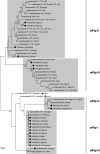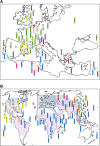Population structure of Wolbachia and cytoplasmic introgression in a complex of mosquito species
- PMID: 24006922
- PMCID: PMC3846486
- DOI: 10.1186/1471-2148-13-181
Population structure of Wolbachia and cytoplasmic introgression in a complex of mosquito species
Abstract
Background: The maternally inherited bacterium Wolbachia often acts as a subtle parasite that manipulates insect reproduction, resulting potentially in reproductive isolation between host populations. Whilst distinct Wolbachia strains are documented in a group of evolutionarily closely related mosquitoes known as the Culex pipiens complex, their impact on mosquito population genetics remains unclear. To this aim, we developed a PCR-RFLP test that discriminates the five known Wolbachia groups found in this host complex. We further examined the Wolbachia genetic diversity, the variability in the coinherited host mitochondria and their partitioning among members of the Cx. pipiens complex, in order to assess the impact of Wolbachia on host population structure.
Results: There was a strong association between Wolbachia and mitochondrial haplotypes indicating a stable co-transmission in mosquito populations. Despite evidence that members of the Cx. pipiens complex are genetically distinct on the basis of nuclear DNA, the association of Wolbachia and mtDNA with members of the Cx. pipiens complex were limited. The Wolbachia wPip-I group, by far the most common, was associated with divergent Cx. pipiens members, including Cx. quinquefasciatus, Cx. pipiens pipiens form pipiens and Cx. pipiens pipiens form molestus. Four other wPip groups were also found in mosquito populations and all were shared between diverse Cx. pipiens members.
Conclusion: This data overall supports the hypothesis that wPip infections, and their allied mitochondria, are associated with regular transfers between Cx. pipiens members rather than specific host associations. Overall, this is suggestive of a recent and likely ongoing cytoplasmic introgression through hybridization events across the Cx. pipiens complex.
Figures



Similar articles
-
Genetic diversity of Culex pipiens mosquitoes in distinct populations from Europe: contribution of Cx. quinquefasciatus in Mediterranean populations.Parasit Vectors. 2016 Jan 27;9:47. doi: 10.1186/s13071-016-1333-8. Parasit Vectors. 2016. PMID: 26818097 Free PMC article.
-
Wolbachia diversity and cytoplasmic incompatibility patterns in Culex pipiens populations in Turkey.Parasit Vectors. 2018 Mar 20;11(1):198. doi: 10.1186/s13071-018-2777-9. Parasit Vectors. 2018. PMID: 29558974 Free PMC article.
-
Diversification of Wolbachia endosymbiont in the Culex pipiens mosquito.Mol Biol Evol. 2011 Oct;28(10):2761-72. doi: 10.1093/molbev/msr083. Epub 2011 Apr 22. Mol Biol Evol. 2011. PMID: 21515811
-
The Culex pipiens complex in the Mississippi River basin: identification, distribution, and bloodmeal hosts.J Am Mosq Control Assoc. 2012 Dec;28(4 Suppl):93-9. doi: 10.2987/8756-971X-28.4.93. J Am Mosq Control Assoc. 2012. PMID: 23401948 Review.
-
A review of the status and significance of the species within the Culex pipiens group in Australia.J Am Mosq Control Assoc. 2012 Dec;28(4 Suppl):24-7. doi: 10.2987/8756-971X-28.4s.24. J Am Mosq Control Assoc. 2012. PMID: 23401942 Review.
Cited by
-
Ancient origin of an urban underground mosquito.bioRxiv [Preprint]. 2025 Feb 5:2025.01.26.634793. doi: 10.1101/2025.01.26.634793. bioRxiv. 2025. PMID: 39975080 Free PMC article. Preprint.
-
Evolution and phylogeography of Culex pipiens densovirus.Virus Evol. 2019 Nov 30;5(2):vez053. doi: 10.1093/ve/vez053. eCollection 2019 Jul. Virus Evol. 2019. PMID: 31807318 Free PMC article.
-
Screening of natural Wolbachia infection in mosquitoes (Diptera: Culicidae) from the Cape Verde islands.Parasit Vectors. 2023 Apr 25;16(1):142. doi: 10.1186/s13071-023-05745-w. Parasit Vectors. 2023. PMID: 37098535 Free PMC article.
-
Prevalence and genetic diversity of Wolbachia endosymbiont and mtDNA in Palearctic populations of Drosophila melanogaster.BMC Evol Biol. 2019 Feb 26;19(Suppl 1):48. doi: 10.1186/s12862-019-1372-9. BMC Evol Biol. 2019. PMID: 30813886 Free PMC article.
-
Culex-Transmitted Diseases: Mechanisms, Impact, and Future Control Strategies using Wolbachia.Viruses. 2024 Jul 15;16(7):1134. doi: 10.3390/v16071134. Viruses. 2024. PMID: 39066296 Free PMC article. Review.
References
Publication types
MeSH terms
Substances
LinkOut - more resources
Full Text Sources
Other Literature Sources

